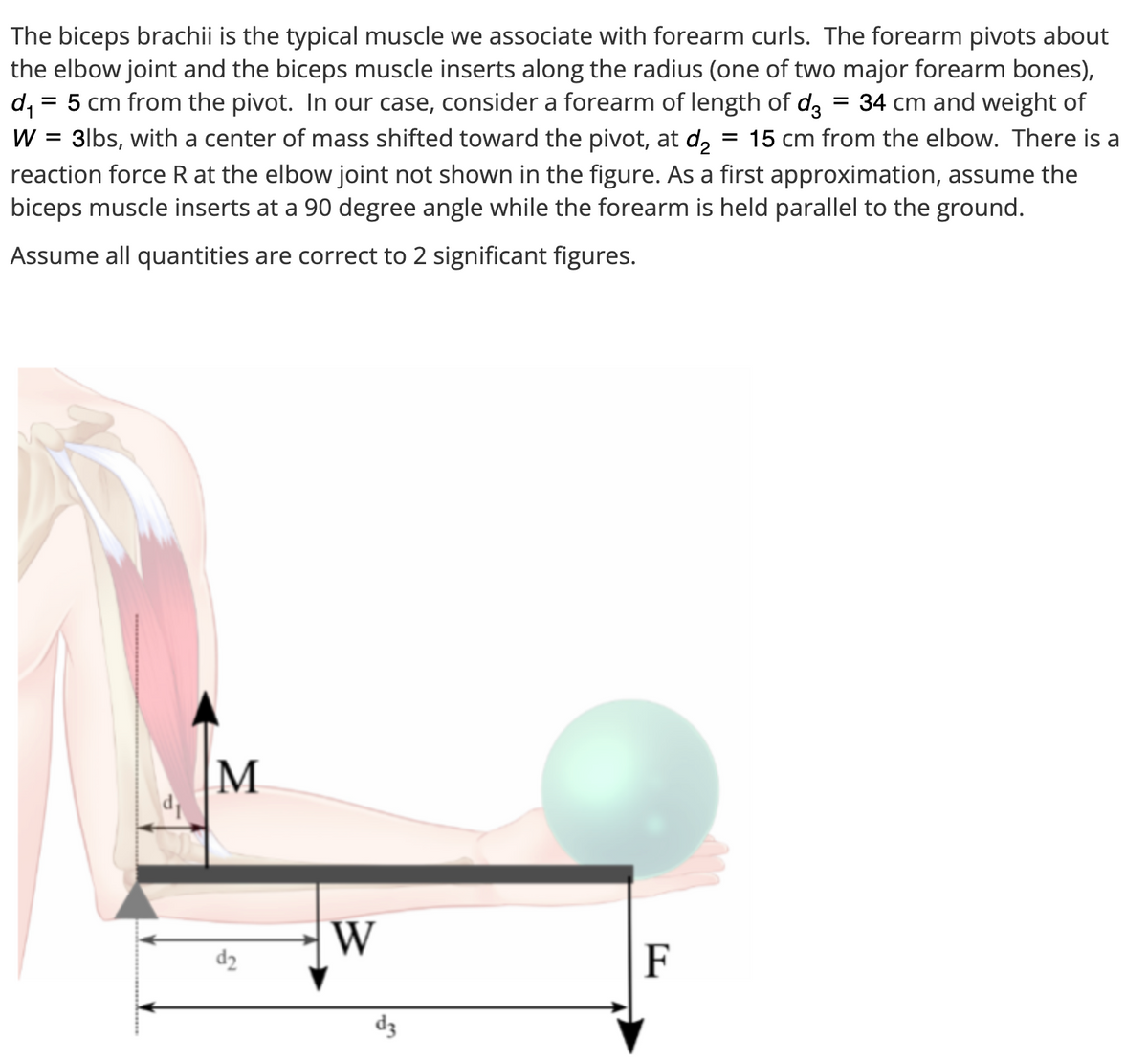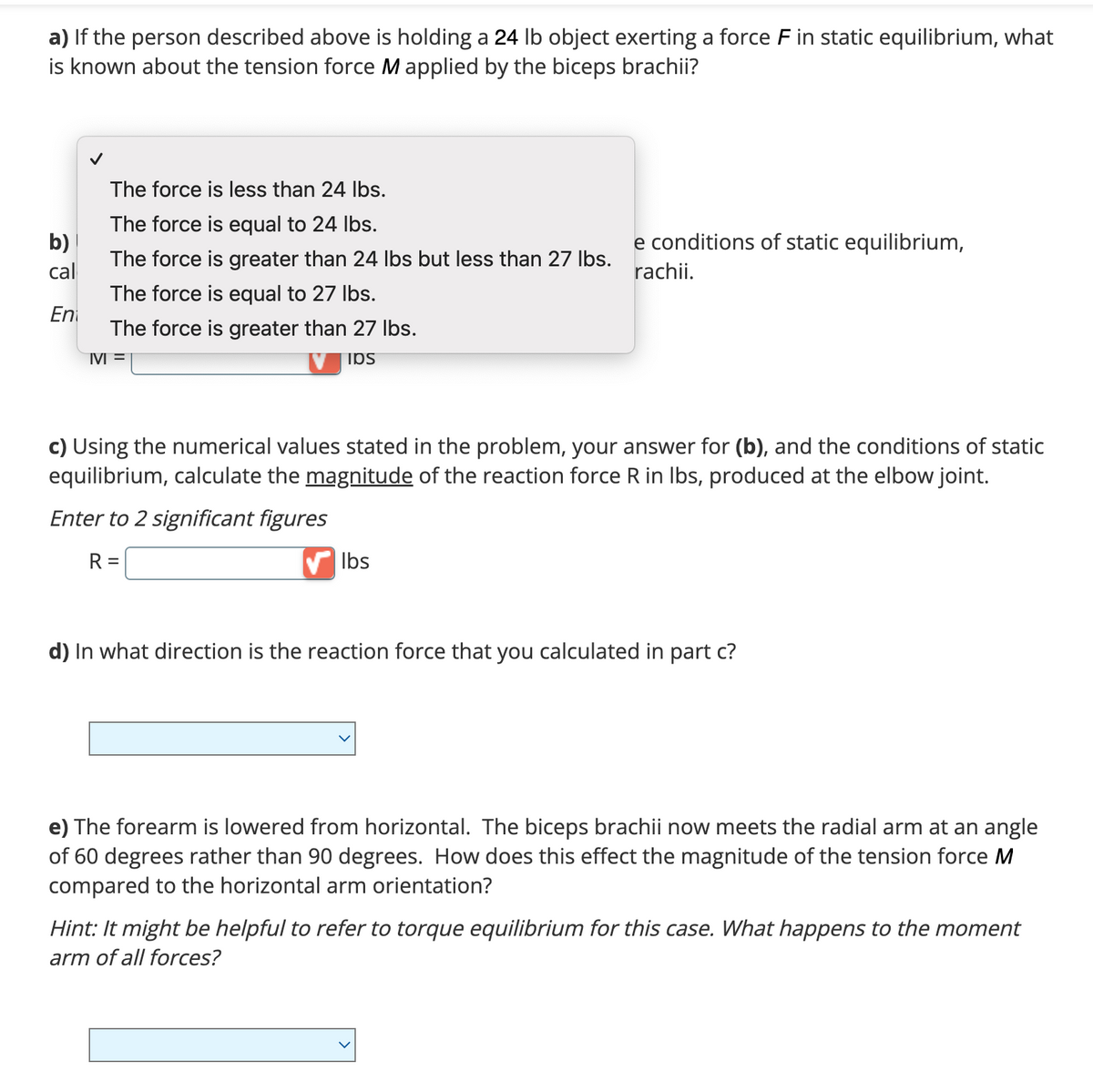The biceps brachii is the typical muscle we associate with forearm curls. The forearm pivots about the elbow joint and the biceps muscle inserts along the radius (one of two major forearm bones), d₁ = 5 cm from the pivot. In our case, consider a forearm of length of d3 = 34 cm and weight of W = 3lbs, with a center of mass shifted toward the pivot, at d₂ = 15 cm from the elbow. There is a reaction force R at the elbow joint not shown in the figure. As a first approximation, assume the biceps muscle inserts at a 90 degree angle while the forearm is held parallel to the ground. Assume all quantities are correct to 2 significant figures.
The biceps brachii is the typical muscle we associate with forearm curls. The forearm pivots about the elbow joint and the biceps muscle inserts along the radius (one of two major forearm bones), d₁ = 5 cm from the pivot. In our case, consider a forearm of length of d3 = 34 cm and weight of W = 3lbs, with a center of mass shifted toward the pivot, at d₂ = 15 cm from the elbow. There is a reaction force R at the elbow joint not shown in the figure. As a first approximation, assume the biceps muscle inserts at a 90 degree angle while the forearm is held parallel to the ground. Assume all quantities are correct to 2 significant figures.
Elements Of Electromagnetics
7th Edition
ISBN:9780190698614
Author:Sadiku, Matthew N. O.
Publisher:Sadiku, Matthew N. O.
ChapterMA: Math Assessment
Section: Chapter Questions
Problem 1.1MA
Related questions
Question
please answer

Transcribed Image Text:The biceps brachii is the typical muscle we associate with forearm curls. The forearm pivots about
the elbow joint and the biceps muscle inserts along the radius (one of two major forearm bones),
d₁ = 5 cm from the pivot. In our case, consider a forearm of length of d3 = 34 cm and weight of
W 3lbs, with a center of mass shifted toward the pivot, at d₂ = 15 cm from the elbow. There is a
reaction force R at the elbow joint not shown in the figure. As a first approximation, assume the
biceps muscle inserts at a 90 degree angle while the forearm is held parallel to the ground.
Assume all quantities are correct to 2 significant figures.
M
d₂
W
d3
F

Transcribed Image Text:a) If the person described above is holding a 24 lb object exerting a force F in static equilibrium, what
is known about the tension force M applied by the biceps brachii?
b)
cal
En
The force is less than 24 lbs.
The force is equal to 24 lbs.
The force is greater than 24 lbs but less than 27 lbs.
The force is equal to 27 lbs.
The force is greater than 27 lbs.
M =
IOS
e conditions of static equilibrium,
rachii.
c) Using the numerical values stated in the problem, your answer for (b), and the conditions of static
equilibrium, calculate the magnitude of the reaction force R in lbs, produced at the elbow joint.
Enter to 2 significant figures
R =
lbs
d) In what direction is the reaction force that you calculated in part c?
e) The forearm is lowered from horizontal. The biceps brachii now meets the radial arm at an angle
of 60 degrees rather than 90 degrees. How does this effect the magnitude of the tension force M
compared to the horizontal arm orientation?
Hint: It might be helpful to refer to torque equilibrium for this case. What happens to the moment
arm of all forces?
Expert Solution
This question has been solved!
Explore an expertly crafted, step-by-step solution for a thorough understanding of key concepts.
Step by step
Solved in 3 steps with 12 images

Knowledge Booster
Learn more about
Need a deep-dive on the concept behind this application? Look no further. Learn more about this topic, mechanical-engineering and related others by exploring similar questions and additional content below.Recommended textbooks for you

Elements Of Electromagnetics
Mechanical Engineering
ISBN:
9780190698614
Author:
Sadiku, Matthew N. O.
Publisher:
Oxford University Press

Mechanics of Materials (10th Edition)
Mechanical Engineering
ISBN:
9780134319650
Author:
Russell C. Hibbeler
Publisher:
PEARSON

Thermodynamics: An Engineering Approach
Mechanical Engineering
ISBN:
9781259822674
Author:
Yunus A. Cengel Dr., Michael A. Boles
Publisher:
McGraw-Hill Education

Elements Of Electromagnetics
Mechanical Engineering
ISBN:
9780190698614
Author:
Sadiku, Matthew N. O.
Publisher:
Oxford University Press

Mechanics of Materials (10th Edition)
Mechanical Engineering
ISBN:
9780134319650
Author:
Russell C. Hibbeler
Publisher:
PEARSON

Thermodynamics: An Engineering Approach
Mechanical Engineering
ISBN:
9781259822674
Author:
Yunus A. Cengel Dr., Michael A. Boles
Publisher:
McGraw-Hill Education

Control Systems Engineering
Mechanical Engineering
ISBN:
9781118170519
Author:
Norman S. Nise
Publisher:
WILEY

Mechanics of Materials (MindTap Course List)
Mechanical Engineering
ISBN:
9781337093347
Author:
Barry J. Goodno, James M. Gere
Publisher:
Cengage Learning

Engineering Mechanics: Statics
Mechanical Engineering
ISBN:
9781118807330
Author:
James L. Meriam, L. G. Kraige, J. N. Bolton
Publisher:
WILEY